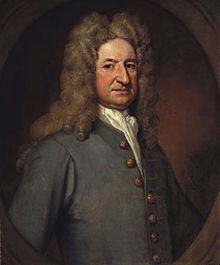
Henry Wise (gardener)

Henry Wise | |
|---|---|
 | |
| Born | 4 September 1653 |
| Died | 1738 (aged 84–85) |
Henry Wise (bapt. 4 September 1653[1] – 15 December 1738) was an English gardener, designer, and nurseryman. He was apprenticed to George London, working at Brompton Nursery, on the present site of the Victoria and Albert Museum, London. The two later worked as partners on parterre gardens at Hampton Court, Chelsea Hospital, Longleat, Chatsworth, Melbourne Hall, Wimpole Hall and Castle Howard, drawing inspiration from engravings of contemporary garden designs in France and the Netherlands.[citation needed]

Wise and London translated into English two well-known French texts on gardening. The resulting work was titled "The Retir'd Gard'ner, in Two Volumes: the Whole Revis'd, with Several Alterations and Additions, Which Render It Proper for Our English Culture." The book was printed in London in 1706 and went through several printings thanks to its popularity.[2]

Kensington Gardens were laid out by Henry Wise and Charles Bridgeman with fashionable features including the Round Pond, formal avenues and a sunken Dutch garden.[3]

Queen Anne and King George I both appointed him to the post of Royal Gardener.[4] Although the Brompton nursery passed into other hands, Wise retained the house, Brompton Park. His will, in 1734, directed his heir to remove all the pictures remaining at Brompton to his house at Warwick.[5]

Wise became wealthy through his gardening endeavours and purchased the manor of The Priory, Warwick.[6] He purchased the estate and the mansion and retired there as a country squire in 1727.[7][8] Henry Wise died at The Priory on 15 Dec 1738, said to be worth some £200,000 – far more, probably, than some of his clients.[9]

The writer and garden designer Stephen Switzer trained with London and Wise.

Notes
- ^ Probably at St. Alfege, Greenwich. (George Royle, "Family Links between George London and John Rose: New Light on the 'Pineapple Paintings'" Garden History 23.2 (Winter 1995, pp. 246–249) p. 249, note 2).
- ^ The Retir'd Gard'ner, in Two Volumes: the Whole Revis'd, with Several Alterations and Additions, Which Render It Proper for Our English Culture, George London, Henry Wise, 1706, Stanford University Library acquisition Archived 10 June 2007 at the Wayback Machine
- ^ For the historicist phantom of the "Dutch" garden, see David Jacques, "Who Knows What a Dutch Garden Is?" Garden History 30.2 (Winter 2002), pp. 114–130.
- ^ The Cambridge History of Science, Roy Porter (ed.), Cambridge University Press, Cambridge, 2003
- ^ Royle 1995:248.
- ^ Henry Wise the 'eminent landscape gardener,' Lillington Manor, A History of the County of Warwick, L.F. Salzman, 1951, Victoria County History, British History Online
- ^ Leek Wootton Site Archived 20 August 2008 at the Wayback Machine
- ^ The borough of Warwick, the suburbs from ca. 1600, A History of the County of Warwick, W.B. Stephens, 1969, Victoria County History, British History Online
- ^ . Dictionary of National Biography. London: Smith, Elder & Co. 1885–1900.
Further reading
- Green, David B. Gardener to Queen Anne: Henry Wise and the Formal Garden (Oxford University Press) 1956.
- Harvey, John. Early Nurserymen 1974.
- Willson, E.J. West London Nursery Gardens (Fulham and Hammersmith Historical Society) 1982.
- Charles Quest-Ritson (2004). The English Garden: A Social History. David R. Godine. ISBN 1567922643.
See what we do next...
OR
By submitting your email or phone number, you're giving mschf permission to send you email and/or recurring marketing texts. Data rates may apply. Text stop to cancel, help for help.
Success: You're subscribed now !
